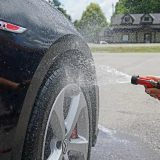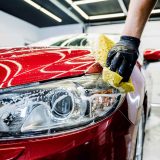Paint correction is a process that involves restoring and rejuvenating the paintwork of a car to remove imperfections and restore its original shine. It is a meticulous process that requires skill, knowledge, and the right tools and products. Maintaining your car's paint is important not only for aesthetic reasons but also for protecting the underlying metal from corrosion and other damage.
Key Takeaways
- Paint correction is a process of removing imperfections from a car's paintwork to restore its original shine and finish.
- Common paint defects include swirl marks, scratches, and oxidation, which can be caused by improper washing, environmental factors, or wear and tear.
- Benefits of paint correction include improved appearance, protection against further damage, and increased resale value.
- Choosing the right tools and products, such as a dual-action polisher and quality polishing compounds, is crucial for achieving a successful paint correction.
- Preparing your car for paint correction involves washing, drying, and decontaminating the surface to ensure a clean and smooth surface for polishing.
Understanding Paint Defects
There are various types of paint defects that can occur on a car's surface. Swirl marks, scratches, oxidation, water spots, and holograms are some common examples. Swirl marks are fine scratches that create a circular pattern on the paint surface, usually caused by improper washing or drying techniques. Scratches can occur from various sources such as keys, tree branches, or even improper washing techniques. Oxidation is the process where the paint loses its shine and becomes dull due to exposure to UV rays and environmental contaminants.These paint defects can be caused by a variety of factors. Improper washing and drying techniques, using harsh chemicals, exposure to UV rays, environmental contaminants, and even improper storage can all contribute to the formation of paint defects. It is important to understand the causes of these defects in order to prevent them from occurring in the first place.
Benefits of Paint Correction
Paint correction offers several benefits for your car. Firstly, it improves the appearance of your car by removing imperfections and restoring its original shine. This can make your car look newer and more attractive. Secondly, paint correction can increase the resale value of your car. A well-maintained paint job can make your car more appealing to potential buyers and can fetch a higher price when it comes time to sell. Lastly, paint correction provides protection against further damage. By removing scratches and swirl marks, you are preventing them from getting worse and potentially causing more damage to the underlying metal.
Choosing the Right Tools and Products
| Tool/Product | Description | Pros | Cons |
|---|
| Google Analytics | A web analytics service offered by Google that tracks and reports website traffic. | Free, easy to use, provides detailed insights into website traffic and user behavior. | May not be suitable for large-scale businesses with complex data needs. |
| SEMrush | An all-in-one digital marketing tool that provides insights into SEO, PPC, social media, and content marketing. | Offers a wide range of features, including keyword research, site audit, and competitor analysis. | Can be expensive for small businesses, may have a steep learning curve for beginners. |
| Hootsuite | A social media management tool that allows users to schedule and publish content across multiple social media platforms. | Offers a centralized platform for managing social media accounts, provides analytics and reporting features. | May not be suitable for businesses with complex social media needs, can be expensive for larger teams. |
| Trello | A project management tool that uses boards, lists, and cards to organize tasks and projects. | Easy to use, offers a visual way to organize tasks and projects, can be customized to fit different workflows. | May not be suitable for large-scale projects with complex dependencies, lacks advanced reporting features. |
Choosing the right tools and products is crucial for achieving the best results in paint correction. There are different types of polishers available, such as rotary polishers and dual-action polishers. Rotary polishers are more aggressive and are best suited for experienced users, while dual-action polishers are more beginner-friendly and provide a safer option for those new to paint correction. It is important to choose the right type of polisher based on your skill level and the severity of the paint defects.In addition to the polisher, you will also need different types of polishing pads. These pads come in various levels of aggressiveness, from cutting pads for heavy defect removal to finishing pads for final polishing. The choice of pad will depend on the type and severity of the paint defects you are dealing with.Polishing compounds are another important aspect of paint correction. These compounds contain abrasive particles that help remove imperfections from the paint surface. There are different types of compounds available, ranging from heavy-cut compounds for severe defects to light-cut compounds for minor imperfections. Choosing the right compound is essential for achieving the desired results without causing any damage to the paint.
Preparing Your Car for Paint Correction
Before starting the paint correction process, it is important to properly prepare your car. This involves washing and drying your car thoroughly to remove any dirt, grime, or contaminants that may be on the surface. It is recommended to use a pH-neutral car shampoo and a microfiber wash mitt or sponge for washing.After washing, it is advisable to use a clay bar treatment to remove any embedded contaminants that may not have been removed during the washing process. Clay bars work by gently pulling out these contaminants from the paint surface, leaving it smooth and ready for correction.Lastly, it is important to mask off areas that do not require correction, such as trim pieces or rubber seals. This will prevent any accidental damage or product transfer onto these areas during the correction process.
Step-by-Step Guide to Paint Correction
Paint correction is a step-by-step process that involves working on small sections at a time. It is recommended to start with the least aggressive method and gradually increase the aggressiveness if needed. This helps minimize the risk of causing any damage to the paint.To begin, apply a small amount of polishing compound onto the pad and spread it evenly on the paint surface. Turn on the polisher and work in overlapping motions, applying light to moderate pressure. It is important to keep the pad flat on the surface and avoid applying excessive pressure, as this can cause heat buildup and damage the paint.Work on one section at a time, typically around 2x2 feet, until you achieve the desired level of correction. Check your progress regularly by wiping off the compound residue with a clean microfiber towel. If necessary, repeat the process with a more aggressive pad or compound to further improve the results.
Tips for Achieving a Perfect Finish
Achieving a perfect finish in paint correction requires proper technique and attention to detail. It is important to use the right amount of product and maintain consistent pressure and speed throughout the process. Avoiding common mistakes such as using too much pressure, working on hot surfaces, or using incorrect products can help prevent damage to the paint.Taking your time is also crucial in achieving a perfect finish. Rushing through the process can lead to subpar results and potential damage to the paint. It is important to be patient and thorough in each step of the paint correction process.
Maintaining Your Car's Shine
Once you have completed the paint correction process, it is important to maintain your car's shine to prolong its longevity. Regular washing and waxing are essential for keeping your car's paint in top condition. Use a pH-neutral car shampoo and a soft microfiber wash mitt or sponge for washing, and apply a high-quality car wax or sealant to protect the paint from UV rays and environmental contaminants.Avoid using harsh chemicals or abrasive materials that can damage the paint. It is also recommended to use a paint sealant for added protection. A paint sealant forms a protective layer on the paint surface, helping to repel water, dirt, and other contaminants.
DIY vs. Professional Paint Correction
When it comes to paint correction, you have the option to do it yourself or hire a professional. Both options have their pros and cons. DIY paint correction allows you to save money and gives you the satisfaction of doing the work yourself. However, it requires time, effort, and the right tools and products. It also carries the risk of causing damage to the paint if not done correctly.On the other hand, professional paint correction offers the expertise and experience of trained technicians who have access to professional-grade tools and products. They can achieve superior results in less time and with less risk of causing damage. However, it comes at a higher cost compared to DIY.When deciding between DIY and professional paint correction, consider factors such as your skill level, available time, budget, and the severity of the paint defects. If you are confident in your abilities and have the necessary tools and products, DIY may be a viable option. However, if you lack experience or are dealing with severe defects, it is advisable to seek professional help.
Frequently Asked Questions about Paint Correction
1. How often should I have my car corrected?
The frequency of paint correction depends on various factors such as the condition of your car's paint, your driving habits, and environmental factors. In general, it is recommended to have your car corrected every 1-2 years to maintain its appearance and protect it from further damage.2. Can paint correction fix deep scratches?
Paint correction can improve the appearance of deep scratches, but it may not be able to completely remove them. In some cases, touch-up paint or more extensive repair may be required to fully fix deep scratches.3. Will paint correction remove all imperfections?
While paint correction can significantly improve the appearance of your car's paint and remove many imperfections, it may not be able to completely eliminate all defects. Some deep scratches or severe damage may require more extensive repair or repainting.If you're interested in paint correction, you might also want to check out this article on Fleet Details about a silver Ford Edge. This article provides valuable insights into the process of paint correction and how it can transform the appearance of a vehicle. To read more about it, click
here.





